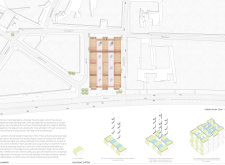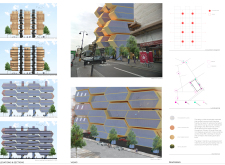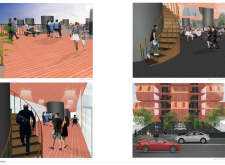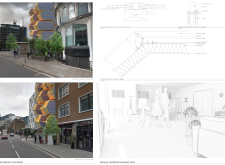5 key facts about this project
In terms of function, this project serves as a multifaceted living environment conducive to urban life. Each module acts as a self-contained unit, yet the overall arrangement is intended to foster interaction among residents, creating opportunities for communal spaces while respecting individual privacy. The resulting architecture marries the principles of modern living with thoughtful design, emphasizing connectivity and accessibility in an increasingly dense urban setting.
The layout reveals a well-considered strategy to respond to the existing street environment, making use of linear arrangements that integrate seamlessly with neighboring structures. With careful attention to both the scale and proportions of the modules, the design effectively complements the urban fabric, avoiding the potential pitfalls of isolation frequently observed in high-density housing projects. The inclusion of varied heights throughout the modules contributes to a dynamic skyline while ensuring that natural light and ventilation permeate shared and private spaces alike.
Important details within the project highlight the commitment to sustainable building practices. The strategic use of timber as a primary structural material underscores a focus on lightweight yet durable solutions. This not only facilitates ease of construction but also enhances the thermal performance of the units, contributing to energy efficiency. In addition, polycarbonate sheets have been incorporated into the façade design, allowing for ample light while creating a sense of fluidity between the external and internal environments. Steel components provide the necessary structural integrity, particularly in supporting elevated modules and ensuring safety across various levels.
The integration of greenery throughout the design reflects a growing awareness of biophilic principles, recognizing the importance of nature in urban living. Landscaped terraces, vertical gardens, and green buffers are thoughtfully integrated to promote environmental benefits along with aesthetic value. These features not only help in reducing the urban heat island effect but also create pleasant spaces for relaxation and interaction among residents.
Unique design approaches are abundantly apparent in the modular configurations. The use of hexagonal shapes references natural forms while promoting structural efficiency, allowing for easy stacking and rearrangement of units. This innovative approach to the design offers flexibility for future growth and adaptability, making the architecture resilient to changing demographic needs. Furthermore, the open terraces included in each module provide an extension of living space, encouraging outdoor activities and fostering a connection to the urban environment.
The overall composition reflects a balanced harmony between built and natural environments, portraying how modern architecture can effectively integrate both aspects within urban confines. Through careful curation of materials, spatial planning, and communal focus, this project stands as a contemporary response to the evolving demands of city living.
Readers interested in architectural plans, architectural sections, and broader architectural ideas will find this project particularly insightful. To explore this project further and uncover its unique aspects, consider delving into the project presentation for an in-depth understanding of its design outcomes and innovative solutions.


























